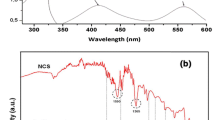Abstract
The clinical use of phospholipid-coated quantum dots (QDs)–photosensitizer complexes as therapeutic nanoagents depends on colloidal stability of these complexes and efficiency of Förster resonance energy transfer from QDs to bound photosensitizer molecules. In this study, we demonstrate modification of CdSe/ZnS QDs with different phospholipids such as 1,2-dipalmitoyl-sn-glycero-3-phosphoethanolamine-N-[methoxy(polyethylene glycol)-2000] (PEG–DPPE); 1,2-dioleoyl-sn-glycero-3-phosphoethanolamine-N-[methoxy(polyethylene glycol)-2000 (PEG–DOPE) and 1,2-dioleoyl-sn-glycero-3-phosphocholine (DOPC) and the complex formation with photosensitizer chlorin e6 (Ce6). QDs were successfully solubilized in water by coating QDs with PEG–DPPE and PEG–DOPE phospholipids. However, an attempt to solubilize QDs using PEG-free phospholipids (DOPC) was ineffective. While QDs modified with DOPC:PEG–DOPE mixtures at molar ratios of 1:1 and 2:1 showed long-term stability in aqueous solution, colloidal solution of QDs modified by DOPC:PEG–DPPE (molar ratio 2:1) was unstable. We showed that Ce6 forms a stable complex only with QDs coated with unsaturated phospholipids PEG–DOPE and DOPC:PEG–DOPE. Close localization of Ce6 molecules to the core of QDs ensures efficient energy transfer from QDs to bound Ce6 molecules that is crucial for its further application in photodynamic therapy of cancer.





Similar content being viewed by others
References
Ananthanarayanan B, Little L, Schaffer DV, Healy KE, Tirrell M (2010) Neural stem cell adhesion and proliferation on phospholipid bilayers functionalized with RGD peptides. Biomaterials 31(33):8706–8715
Bakalova R, Ohba H, Zhelev Z, Ishikawa M, Baba Y (2004) Quantum dots as photosensitizers? Nat Biotechnol 22(11):1360–1361
Bavireddi H, Kikkeri R (2012) Glyco-beta-cyclodextrin capped quantum dots: synthesis, cytotoxicity and optical detection of carbohydrate–protein interactions. The Analyst 137(21):5123–5127
Chang YP, Pinaud F, Antelman J, Weiss S (2008) Tracking bio-molecules in live cells using quantum dots. J Biophotonics 1(4):287–298
Dubertret B, Skourides P, Norris DJ, Noireaux V, Brivanlou AH, Libchaber A (2002) In vivo imaging of quantum dots encapsulated in phospholipid micelles. Science 298(5599):1759–1762
Edwards K, Johnsson M, Karlsson G, Silvander M (1997) Effect of polyethyleneglycol-phospholipids on aggregate structure in preparations of small unilamellar liposomes. Biophys J 73(1):258–266
Frolov AA, Zenkevich EI, Gurinovich GP, Kochubeyev GA (1990) Chlorin e6-liposome interaction. Investigation by the methods of fluorescence spectroscopy and inductive resonance energy transfer. J Photochem Photobiol B Biol 7(1):43–56
Janczewski D, Tomczak N, Han MY, Vancso GJ (2011) Synthesis of functionalized amphiphilic polymers for coating quantum dots. Nat Protoc 6(10):1546–1553
Johnsson M, Edwards K (2003) Liposomes, disks, and spherical micelles: aggregate structure in mixtures of gel phase phosphatidylcholines and poly(ethylene glycol)-phospholipids. Biophys J 85(6):3839–3847
Kaul Z, Yaguchi T, Kaul SC, Hirano T, Wadhwa R, Taira K (2003) Mortalin imaging in normal and cancer cells with quantum dot immuno-conjugates. Cell Res 13(6):503–507
Lakowicz J (1999) Principles of fluorescence spectroscopy, 2nd edn. Kluwer Academic/Plenum Publishers, New York
Ma N, Marshall AF, Gambhir SS, Rao J (2010) Facile synthesis, silanization, and biodistribution of biocompatible quantum dots. Small 6(14):1520–1528
Magde D, Rojas GE, Seybold PG (1999) Solvent dependence of the fluorescence lifetimes of xanthene dyes. Photochem Photobiol 70(5):737–744
Mojzisova H, Bonneau S, Vever-Bizet C, Brault D (2007) The pH-dependent distribution of the photosensitizer chlorin e6 among plasma proteins and membranes: a physico-chemical approach. Biochim Biophys Acta 1768(2):366–374
Peng ZA, Peng X (2001) Formation of high-quality CdTe, CdSe, and CdS nanocrystals using CdO as precursor. J Am Chem Soc 123(1):183–184
Peng ZA, Peng X (2002) Nearly monodisperse and shape-controlled CdSe nanocrystals via alternative routes: nucleation and growth. J Am Chem Soc 124(13):3343–3353
Pong BK, Trout BL, Lee JY (2008) Modified ligand-exchange for efficient solubilization of CdSe/ZnS quantum dots in water: a procedure guided by computational studies. Langmuir 24(10):5270–5276
Ramanavicius A, Karabanovas V, Ramanaviciene A, Rotomskis R (2009) Stabilization of (CdSe)ZnS quantum dots with polypyrrole formed by UV/VIS irradiation initiated polymerization. J Nanosci Nanotechnol 9(3):1909–1915
Rogach AL, Katsikas L, Kornowski A, Su D, Eychmüller A, Weller H (1996) Synthesis and characterization of thiol-stabilized CdTe nanocrystals. Ber Bunsenges Phys Chem 100(11):1772–1778
Rotomskis R, Valanciunaite J, Skripka A, Steponkiene S, Spogis G, Bagdonas S, Streckyte G (2013) Complexes of functionalized quantum dots and chlorin e6 in photodynamic therapy. Lith J Phys 53(1):57–68
Samia ACS, Chen X, Burda C (2003) Semiconductor quantum dots for photodynamic therapy. J Am Chem Soc 125(51):15736–15737
Skripka A, Valanciunaite J, Dauderys G, Poderys V, Kubiliute R, Rotomskis R (2013) Two-photon excited quantum dots as energy donors for photosensitizer chlorin e6. J Biomed Opt 18(7):078002
Steponkiene S, Valanciunaite J, Skripka A, Rotomskis R (2014) Cellular uptake and photosensitizing properties of quantum dot–chlorin e6 complex In Vitro Study. J Biomed Nanotechnol 10(4):679–686
Tong S, Hou S, Ren B, Zheng Z, Bao G (2011) Self-assembly of phospholipid-PEG coating on nanoparticles through dual solvent exchange. Nano Lett 11(9):3720–3726
Valanciunaite J, Skripka A, Streckyte G, Rotomskis R (2010) Complex of water-soluble CdSe/ZnS quantum dots and chlorin e6: interaction and FRET.737607-737607. doi:10.1117/12.871524
Vermathen M, Marzorati M, Vermathen P, Bigler P (2010) pH-dependent distribution of chlorin e6 derivatives across phospholipid bilayers probed by NMR spectroscopy. Langmuir 26(13):11085–11094
Wang Y, Wong JF, Teng X, Lin XZ, Yang H (2003) “Pulling” nanoparticles into water: phase transfer of oleic acid stabilized monodisperse nanoparticles into aqueous solutions of α-cyclodextrin. Nano Lett 3(11):1555–1559
Wu X, Liu H, Liu J, Haley KN, Treadway JA, Larson JP, Ge N, Peale F, Bruchez MP (2003) Immunofluorescent labeling of cancer marker Her2 and other cellular targets with semiconductor quantum dots. Nat Biotechnol 21(1):41–46
Zhang Y, Görner H (2009) Photoprocesses of chlorin e6 bound to lysozyme or bovin serum albumin. Dyes Pigm 83(2):174–179
Acknowledgments
This work was supported by grant (No. MIP-095/2011) from the Research Council of Lithuania. J. V. was supported by the project “Postdoctoral Fellowship Implementation in Lithuania” funded by European Union Structural Fund. A.S. was supported by the Lithuanian Science Council Student Research Fellowship Award. The authors have no conflicts of interest to declare.
Author information
Authors and Affiliations
Corresponding author
Electronic supplementary material
Below is the link to the electronic supplementary material.
Rights and permissions
About this article
Cite this article
Karabanovas, V., Skripka, A., Valanciunaite, J. et al. Formation of self-assembled quantum dot–chlorin e6 complex: influence of nanoparticles phospholipid coating. J Nanopart Res 16, 2508 (2014). https://doi.org/10.1007/s11051-014-2508-x
Received:
Accepted:
Published:
DOI: https://doi.org/10.1007/s11051-014-2508-x




